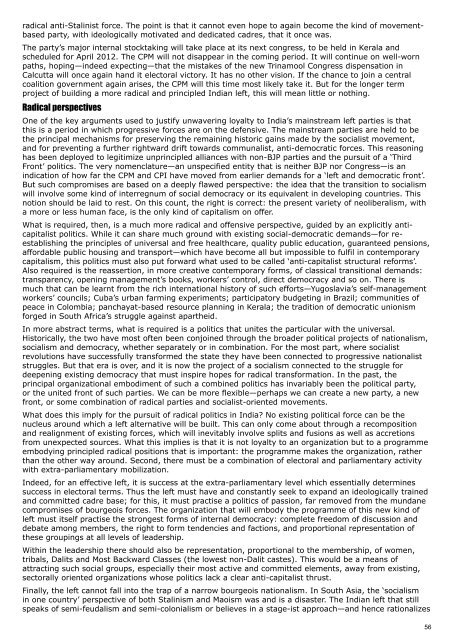here - International Viewpoint
here - International Viewpoint
here - International Viewpoint
Create successful ePaper yourself
Turn your PDF publications into a flip-book with our unique Google optimized e-Paper software.
adical anti-Stalinist force. The point is that it cannot even hope to again become the kind of movementbased<br />
party, with ideologically motivated and dedicated cadres, that it once was.<br />
The party’s major internal stocktaking will take place at its next congress, to be held in Kerala and<br />
scheduled for April 2012. The CPM will not disappear in the coming period. It will continue on well-worn<br />
paths, hoping—indeed expecting—that the mistakes of the new Trinamool Congress dispensation in<br />
Calcutta will once again hand it electoral victory. It has no other vision. If the chance to join a central<br />
coalition government again arises, the CPM will this time most likely take it. But for the longer term<br />
project of building a more radical and principled Indian left, this will mean little or nothing.<br />
Radical perspectives<br />
One of the key arguments used to justify unwavering loyalty to India’s mainstream left parties is that<br />
this is a period in which progressive forces are on the defensive. The mainstream parties are held to be<br />
the principal mechanisms for preserving the remaining historic gains made by the socialist movement,<br />
and for preventing a further rightward drift towards communalist, anti-democratic forces. This reasoning<br />
has been deployed to legitimize unprincipled alliances with non-BJP parties and the pursuit of a ‘Third<br />
Front’ politics. The very nomenclature—an unspecified entity that is neither BJP nor Congress—is an<br />
indication of how far the CPM and CPI have moved from earlier demands for a ‘left and democratic front’.<br />
But such compromises are based on a deeply flawed perspective: the idea that the transition to socialism<br />
will involve some kind of interregnum of social democracy or its equivalent in developing countries. This<br />
notion should be laid to rest. On this count, the right is correct: the present variety of neoliberalism, with<br />
a more or less human face, is the only kind of capitalism on offer.<br />
What is required, then, is a much more radical and offensive perspective, guided by an explicitly anticapitalist<br />
politics. While it can share much ground with existing social-democratic demands—for reestablishing<br />
the principles of universal and free healthcare, quality public education, guaranteed pensions,<br />
affordable public housing and transport—which have become all but impossible to fulfil in contemporary<br />
capitalism, this politics must also put forward what used to be called ‘anti-capitalist structural reforms’.<br />
Also required is the reassertion, in more creative contemporary forms, of classical transitional demands:<br />
transparency, opening management’s books, workers’ control, direct democracy and so on. T<strong>here</strong> is<br />
much that can be learnt from the rich international history of such efforts—Yugoslavia’s self-management<br />
workers’ councils; Cuba’s urban farming experiments; participatory budgeting in Brazil; communities of<br />
peace in Colombia; panchayat-based resource planning in Kerala; the tradition of democratic unionism<br />
forged in South Africa’s struggle against apartheid.<br />
In more abstract terms, what is required is a politics that unites the particular with the universal.<br />
Historically, the two have most often been conjoined through the broader political projects of nationalism,<br />
socialism and democracy, whether separately or in combination. For the most part, w<strong>here</strong> socialist<br />
revolutions have successfully transformed the state they have been connected to progressive nationalist<br />
struggles. But that era is over, and it is now the project of a socialism connected to the struggle for<br />
deepening existing democracy that must inspire hopes for radical transformation. In the past, the<br />
principal organizational embodiment of such a combined politics has invariably been the political party,<br />
or the united front of such parties. We can be more flexible—perhaps we can create a new party, a new<br />
front, or some combination of radical parties and socialist-oriented movements.<br />
What does this imply for the pursuit of radical politics in India? No existing political force can be the<br />
nucleus around which a left alternative will be built. This can only come about through a recomposition<br />
and realignment of existing forces, which will inevitably involve splits and fusions as well as accretions<br />
from unexpected sources. What this implies is that it is not loyalty to an organization but to a programme<br />
embodying principled radical positions that is important: the programme makes the organization, rather<br />
than the other way around. Second, t<strong>here</strong> must be a combination of electoral and parliamentary activity<br />
with extra-parliamentary mobilization.<br />
Indeed, for an effective left, it is success at the extra-parliamentary level which essentially determines<br />
success in electoral terms. Thus the left must have and constantly seek to expand an ideologically trained<br />
and committed cadre base; for this, it must practise a politics of passion, far removed from the mundane<br />
compromises of bourgeois forces. The organization that will embody the programme of this new kind of<br />
left must itself practise the strongest forms of internal democracy: complete freedom of discussion and<br />
debate among members, the right to form tendencies and factions, and proportional representation of<br />
these groupings at all levels of leadership.<br />
Within the leadership t<strong>here</strong> should also be representation, proportional to the membership, of women,<br />
tribals, Dalits and Most Backward Classes (the lowest non-Dalit castes). This would be a means of<br />
attracting such social groups, especially their most active and committed elements, away from existing,<br />
sectorally oriented organizations whose politics lack a clear anti-capitalist thrust.<br />
Finally, the left cannot fall into the trap of a narrow bourgeois nationalism. In South Asia, the ‘socialism<br />
in one country’ perspective of both Stalinism and Maoism was and is a disaster. The Indian left that still<br />
speaks of semi-feudalism and semi-colonialism or believes in a stage-ist approach—and hence rationalizes<br />
56









